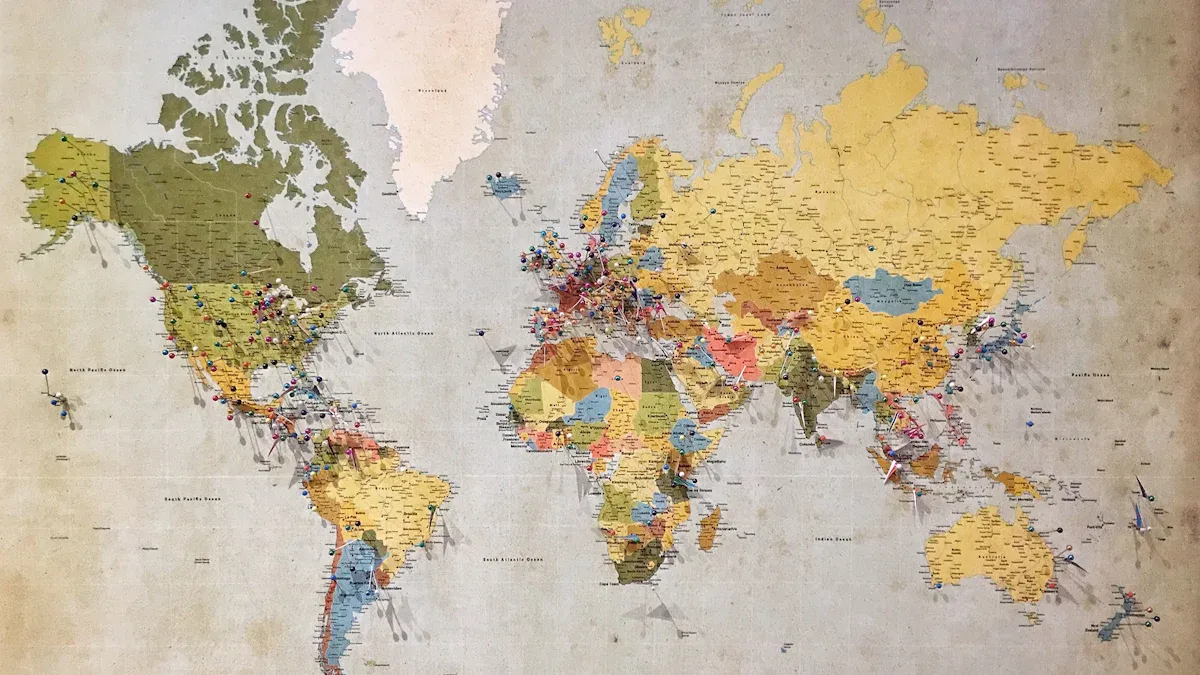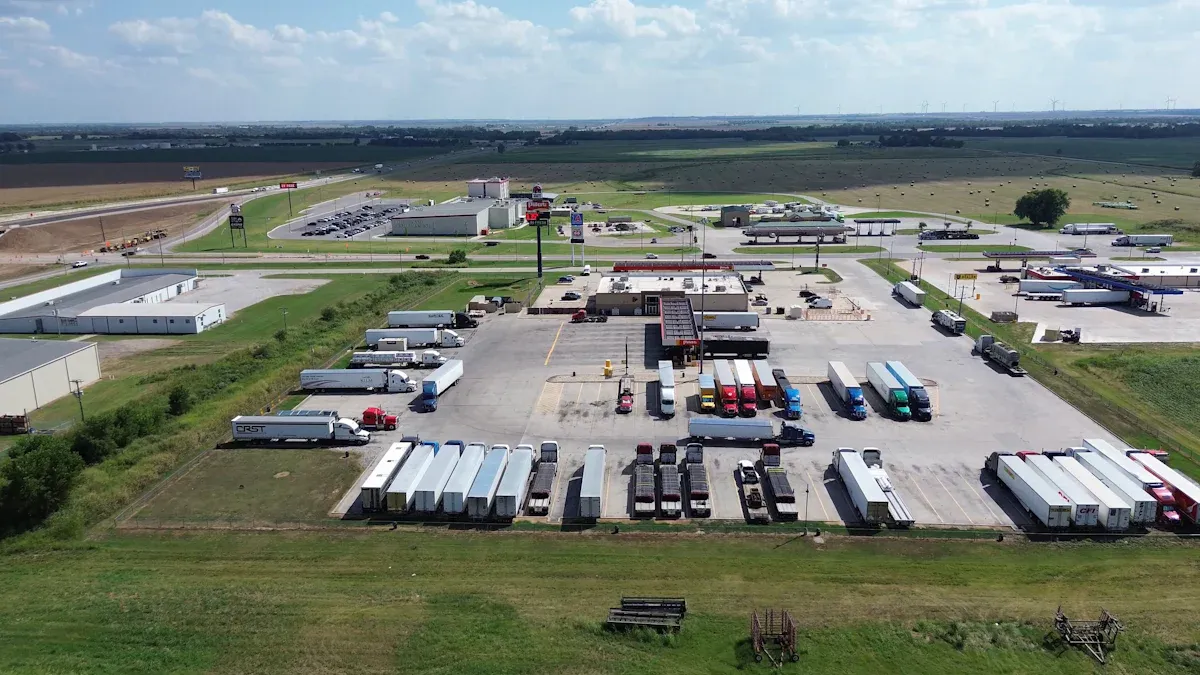Why Midwest Distribution Networks Matter for National Logistics

You benefit from the midwest distribution network importance because the region sits at the heart of the country. The Midwest gives you easy access to major cities. You save money on fuel and reach customers faster.
Lower fuel costs
Quicker delivery times
Strong infrastructure connects highways, rail, and airports. You improve efficiency and reach more markets. Consider how these advantages can strengthen your logistics strategy.
Key Takeaways
Midwest distribution networks offer a central location, allowing quick access to nearly half the U.S. population within two days by ground shipping.
Lower warehousing costs in the Midwest help businesses save money, allowing for investment in growth and flexibility in operations.
Strong infrastructure, including highways, railroads, and airports, enhances delivery speed and reliability, improving customer satisfaction.
Working with third-party logistics providers in the Midwest boosts efficiency and supports sustainability goals, making your supply chain greener.
The Midwest's lower risk of natural disasters ensures a more stable supply chain, helping businesses avoid costly disruptions.
Central Location & Nationwide Reach

Geographic Center Advantage
You gain a major advantage when you use the Midwest for your distribution network. The region sits near the geographic center of the United States. This position lets you reach most of the U.S. population quickly. You can ship goods to both coasts and major cities with ease.
You reach almost half the country within two days by ground shipping.
You save money because shorter routes mean lower transportation costs.
You benefit from strong infrastructure, including highways, railroads, and airports with high cargo capacity.
You face fewer risks from natural disasters, so your supply chain stays reliable.
The Midwest supports just-in-time delivery models, which help you keep inventory levels low and respond to demand faster.
The midwest distribution network importance grows when you consider how easy it is to connect with major markets. For example, the St. Louis region moves over 369,000 tons per mile, making it one of the most efficient inland ports in the country. Indianapolis offers rail ramps that link you to both the East Coast and Gulf ports. The Panama Canal expansion also makes shipping routes to the Midwest more cost-effective.
Location | Advantage |
|---|---|
St. Louis Metro Ports | Moves 369,309 tons per mile, four times more efficient than other ports |
Indianapolis Rail Ramp | Connects to major interstates and rail for fast coast-to-coast shipping |
Panama Canal Expansion | Improves freight movement and lowers shipping costs |
Shorter Transit Times
You deliver products faster when you use Midwest distribution centers. Your customers get their orders sooner, which boosts satisfaction. You also improve inventory management.
A centrally located warehouse helps you keep better track of stock.
You reduce shrinkage and waste, with up to 18% less loss.
You free up labor for customer service, with a 22-25% reduction in inventory labor needs.
You see fewer errors, with inventory accuracy rising from 93% to over 98%.
You experience fewer stockouts, which can increase sales by 3-5%.
Tip: Faster shipping and better inventory control help you compete in today’s market. You meet customer expectations and keep costs down.
You see the midwest distribution network importance in every step of your logistics process. You reach more customers, deliver faster, and manage inventory with greater accuracy.
Midwest Distribution Network Importance & Cost Efficiency
Lower Warehousing Costs
You see the midwest distribution network importance when you compare warehousing costs. The Midwest offers lower prices for storage space than coastal regions. This difference helps you save money and invest in other parts of your business.
Region | Average Cost per Square Foot (Annual) |
|---|---|
Midwest | $6 - $8 |
Coastal Regions | $8 - $12 or more |
You pay less for real estate in the Midwest. Lower labor costs and favorable tax structures also help you reduce expenses. Shorter distances to major markets mean you spend less on shipping. Better infrastructure supports faster and more reliable deliveries. Centralizing logistics in the Midwest allows you to ship products quickly and cut transportation costs.
Note: Lower warehousing costs give you more flexibility to grow your business and respond to market changes.
Optimized Distribution with 3PLs
You boost efficiency when you work with third-party logistics providers in the Midwest. These partners know how to manage warehousing and supply chain operations. They use facilities that can scale with your needs, whether you face seasonal spikes or long-term growth.
Centrally located, ensuring 1–2 day ground shipping to most of the U.S.
Strong access to interstates, rail networks, and ports like Chicago and St. Louis.
Lower warehousing and transportation costs compared to coastal regions.
Skilled logistics workforce that understands supply chain operations.
Facilities across the Midwest can scale with demand.
Selecting the right third-party logistics provider improves delivery times and lowers costs. You make fulfillment a reliable part of your business. The midwest distribution network importance grows when you choose partners who use the region’s geographic advantages. You also support sustainability goals. States like Minnesota, Illinois, Michigan, Wisconsin, and Nebraska plan for 100% clean or carbon-free electricity by 2040 or 2050. These efforts help reduce carbon emissions and make your supply chain greener.
You benefit from the midwest distribution network importance by saving money, improving delivery speed, and supporting sustainability. You build a supply chain that is efficient, flexible, and ready for future growth.
Infrastructure & Supply Chain Connectivity

Highways, Rail, and Airports
You rely on the Midwest’s strong transportation network to move goods quickly and efficiently. The region connects you to major highways, railroads, and airports. This network helps you reach customers across the country. The Midwest ranks high in rail mileage, with Illinois holding the second spot and Wisconsin at fourteenth. You benefit from federal funding that improves rail services in six Midwestern states. These upgrades make your shipments faster and more reliable.
State | Rail Ranking | Rail Mileage Rank |
|---|---|---|
Wisconsin | 14th | N/A |
Illinois | 2nd | N/A |
Major airports in the Midwest support your logistics operations. Indianapolis International Airport stands out with over one million tons of cargo handled in 2015. It hosts the world’s second-largest FedEx hub and offers special handling for temperature-sensitive goods. Cincinnati/Northern Kentucky International Airport grows rapidly, making it a key player in air cargo. Rockford International Airport also rises in FAA rankings.
Airport Name | Location | Cargo Volume (2015) | Notable Features |
|---|---|---|---|
Indianapolis International Airport | Indianapolis, IN | 1,084,857 tons | FedEx hub, five cargo facilities, temperature-sensitive handling |
Cincinnati/Northern Kentucky International Airport | Hebron, KY | N/A | Fastest-growing cargo airport |
Rockford International Airport | Rockford, IL | N/A | Significant air cargo industry role |
You gain access to five major interstates and five railroads, which means you can reach 75% of U.S. businesses within a 36-hour drive. This connectivity gives you a competitive edge.
Link Between Manufacturers and Retailers
You use Midwest distribution networks to connect manufacturers and retailers. Warehousing lets you store and manage goods, so products stay available for retailers. Distribution moves goods from warehouses to stores, using efficient transportation routes. Inventory management helps you track products and fulfill orders on time. Shipping optimizes delivery routes, making sure retailers get products when they need them.
Warehousing keeps products ready for retailers.
Distribution moves goods efficiently from storage to stores.
Inventory management tracks products and supports timely order fulfillment.
Shipping ensures on-time delivery to retailers.
You see the Midwest’s role as a supply chain hub for national retailers. The region supports best practices in sustainable food distribution and uses systems analysis to improve logistics. Government policies also help you by investing in broadband networks and transmission lines. These improvements support economic growth and make your distribution network stronger.
Tip: Use the Midwest’s infrastructure to build a reliable supply chain. You reach more customers and keep your business growing.
Scalability, Flexibility, and Risk Reduction
Room for Growth
You find room for growth when you use Midwest distribution networks. These networks help your business scale up or down as needed. Flexible warehousing lets you adjust your storage space based on seasonal changes or market demands. You do not need to invest heavily in infrastructure. You can focus your resources on your core business activities, which helps you grow faster.
The Columbus Region shows how the Midwest supports expansion. Over 3 million square feet of new logistics space opened in 2023. Facilities like the Rickenbacker Exchange Building filled up quickly. Another 7 million square feet is planned for 2024. This ongoing investment means you have access to modern facilities that support e-commerce and retail growth.
You benefit from advanced technology in Midwest warehouses. Real-time tracking and data analytics help you manage inventory better. You ship products faster because you are close to major highways and cities. This location advantage reduces shipping costs and improves distribution efficiency.
Aspect | Description |
|---|---|
Flexible Warehousing | Adjust storage space for seasonal or market changes. |
Advanced Technology | Use real-time tracking and analytics for inventory management. |
Strategic Location Advantages | Reach major cities quickly and lower shipping costs. |
Tip: You can scale your operations quickly and adapt to market changes with Midwest distribution networks.
Lower Disaster Risk
You lower your risk when you choose Midwest distribution networks. The region faces fewer natural disasters than coastal areas. You avoid hurricanes, wildfires, and earthquakes that can disrupt supply chains. Your shipments stay on schedule more often. You protect your inventory and reduce losses.
Midwest distribution network importance grows when you consider risk reduction. You keep your supply chain stable and reliable. You build trust with your customers because you deliver on time. You also save money by avoiding costly delays and damage.
Fewer natural disasters mean less risk for your business.
Reliable infrastructure keeps your supply chain moving.
Stable operations help you plan for the future.
Note: You gain peace of mind and protect your business when you use Midwest distribution networks.
You gain strategic value when you use Midwest distribution networks. The region offers cost savings, strong infrastructure, and a skilled workforce. You reach major markets quickly and avoid many supply chain disruptions.
Efficient distribution from a central location
Lower operational costs and reliable transportation
Focus on sustainability and future-ready technology
Consider Midwest networks to strengthen your supply chain. You improve efficiency, build resilience, and prepare for future growth.
FAQ
What makes Midwest distribution networks cost-effective?
You save money because warehouse space costs less in the Midwest. Lower labor rates and shorter shipping routes also help you cut expenses.
Tip: Use Midwest locations to stretch your logistics budget further.
How do Midwest networks improve delivery speed?
You reach most U.S. cities quickly from the Midwest. Central warehouses allow you to ship products faster and reduce transit times.
Faster delivery boosts customer satisfaction
Shorter routes mean fewer delays
Are Midwest distribution centers good for scaling my business?
You can grow your business easily with Midwest networks. Flexible warehouse space and strong infrastructure support expansion.
Benefit | Description |
|---|---|
Flexibility | Adjust space as needed |
Connectivity | Reach new markets quickly |
Do Midwest networks help reduce supply chain risks?
You face fewer natural disasters in the Midwest. Reliable infrastructure keeps your shipments moving.
Note: Stable operations help you avoid costly delays and protect your inventory.
See Also
PGL's Efficient Warehouse Solutions for Quick East Coast Shipping
Effective Strategies by PGL for Efficient U.S. Warehousing
PGL's Strategic Warehousing in Miami and LA for Supply Chain Success
Simplifying U.S. Supply Chain Optimization with Global Logistics Solutions
Enhancing Global Efficiency Through Point-to-Point Logistics Systems
